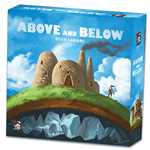
Above And Below Board Game
Your last village was ransacked by barbarians. You barely had time to pick up the baby and your favorite fishing pole before they started the burning and pillaging. You wandered over a cruel desert, braved frozen peaks, and even paddled a log across a rough sea, kicking at the sharks whenever they got too close, the baby strapped tightly to your back.
Then you found it! The perfect place to make your new home. But as soon as you had the first hut built, you discovered a vast network of caverns underground, brimming with shiny treasures, rare resources, and untold adventure. How could you limit your new village to the surface? You immediately start organizing expeditions and building houses underground as well as on the surface.
With any luck, you'll build a village even stronger than your last? strong enough, even, to turn away the barbarians the next time they come knocking.
Above and Below is a mashup of town-building and storytelling where you and up to three friends compete to build the best village above and below ground. In the game, you send your villagers to perform jobs like exploring the cave, harvesting resources, and constructing houses. Each villager has unique skills and abilities, and you must decide how to best use them. You have your own personal village board, and you slide the villagers on this board to various areas to indicate that they've been given jobs to do. Will you send Hanna along on the expedition to the cave? Or should she instead spend her time teaching important skills to one of the young villagers?
A great cavern lies below the surface, ready for you to explore? this is where the storytelling comes in. When you send a group of villagers to explore the depths, one of your friends reads what happens to you from a book of paragraphs. You'll be given a choice of how to react, and a lot will depend on which villagers you brought on the expedition, and who you're willing to sacrifice to succeed. The book of paragraphs is packed with encounters of amazing adventure, randomly chosen each time you visit the cavern.
At the end of the game, the player with the most well-developed village wins!
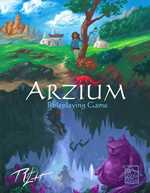
Arzium RPG: World Of Arzium
Arzium Roleplaying Game opens up the World of Arzium: a vast land filled with mysteries, magic, and forgotten technology. Create characters and stories from numerous folk, occupations, and abilities. Then gather a group of friends or foes and make your own adventure! This book is not only a roleplaying game, but a guide to the World of Arzium, with maps, history, lore, and detailed geographical descriptions.
Hardcover containing 200+ pages. New system focuses on narrative choices. Supports GMs, making it easy to prepare. NPC, encounter, and world generation keeps things running smoothly. Five-Attribute system from Sleeping Gods, are treated like resources which support a varied play style. Combat is exciting and deadly. Players have a flexible canvas to create characters. Uses standard RPG dice and core book includes a detailed adventure. Illustrated and designed by Ryan Laukat.
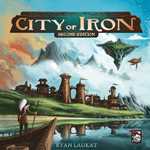
City Of Iron Board Game: 2nd Edition
Far away in the beautiful world of Arzium, four small nations compete to become the most powerful, rallying courageous explorers, cunning leaders, brilliant minds, and powerful magicians. The humans of the City-State of Arc value industry and growth, while their neighbors in the highlands of Cresaria seek out ancient magics and scientific advances. To the south live the toads of Om amid the verdant Emerald Hills, inventing amazing machines and gizmos to aid them. The Hog Republic to the west holds a rich military tradition and teaches ruthless strategy? in war and in business? to all citizens from a young age.
Which nation will emerge as the greatest, leading this new world of advancement into the next century?

Creature Caravan Board Game (On Order)
A new threat lurks in the land of Arzium. Ember zombies swarm from volcanic lands to the north-their charcoal bodies the walking hives of malicious fire fairies. The closest haven is the city of Eastrey (eest-ray), where a powerful artifact protects the inhabitants. You must travel across the desert and the plains, over mountains and through red canyons, helping wandering creatures of every shape and size to the safety of the city.
In Creature Caravan, players assemble a card tableau of creatures while traveling through a magnificent and dangerous land. Players take turns simultaneously, placing dice on actions on their cards and player boards, moving their caravan across the map toward Eastrey, and adding new creature cards to their caravan.
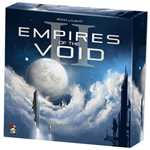
Empires Of The Void II Board Game
Exploring the Fringe of the Galaxy. Your species has traveled for years in a massive Worldship, fleeing from a cruel and unstoppable alien empire. Now, in the distant fringe of the galaxy, you must compete to establish a foothold and grow in strength, preparing for the time when the invaders find you again...
Empires of the Void II tells a story about eight fringe planets and the species that live on them through unique event and action cards. You'll find ancient ruins, stop planetary wars, transport desperate leaders to distant locales, and rescue worlds from imminent invasion. Will you choose to conquer or befriend the aliens you encounter? Your alien allies give you powerful abilities and unique characters that you can recruit.
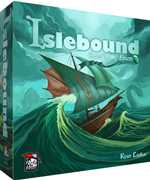
Islebound Board Game: Emerald Edition
Set sail in a mystical archipelago filled with bustling towns, sea monsters, pirates, and gold!
In Islebound Board Game: Emerald Edition you'll compete with others to build the best sea-faring nation by collecting treasure, hiring crew, and conquering or befriending island towns.
Take command of a ship and crew. Sail to island towns, collecting resources, hiring crew, and commissioning buildings for your capital city.
Each building has a unique ability, and your combination of buildings can greatly enhance your strength as a trader, builder, or invader. You also recruit pirates and sea monsters to conquer towns, which, once conquered, allow you to complete their town action for free. Plus, you can charge a fee to opponents if they want to use it.
Alternatively, you can complete events that give influence, which can be used to befriend towns.
There are many routes to success. Will you be a ruthless conqueror, careful diplomat, or shrewd merchant in your race to the top?
The player with the most wealth and most-impressive capital city will win the game!
What kind of captain will you be?
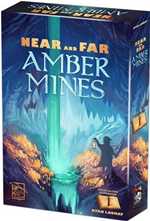
Near And Far Board Game: Amber Mines Expansion
Golden Amber fills the deep mines, its fiery, cold embers glowing in the ancient rocks. Scholars say that the Arzians valued it above gold or silver, and wore it as a sign of wealth. Perhaps the rare substance holds forgotten secrets about the long-dead empire and their lust for power?
Amber Mines is the first expansion to Near & Far. It includes modules that you can add or remove according to your preferences. Amber Mines: This module includes a new Mine tile which you place over the top of the Mine on the town board. It also includes a deck of 43 Amber Mine cards that players can explore. Magic: This module includes a new Mystic's Hut tile (that is combined with the new Mine), a Magic Track tile, and a deck of 30 Spell cards with powerful abilities. New General Store: This module includes a new General Store tile which you place over the top of the General Store on the town board. It has slightly altered actions and gives players another way to place camps. New Threat Cards: This module includes 13 new threat cards. These cards replace the original deck of threat cards in Near & Far.
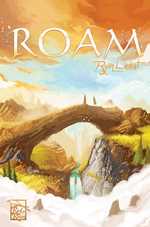
Roam Card Game
Welcome to Arzium, land of ancient civilizations, bizarre creatures, unexplained wonders, and vibrant characters. A great sleeping sickness has spread across the land, sending every type of creature to roam for hundreds of miles in a dazed, incoherent march. It's your job to seek them out and wake them from their sleepwalk, recruiting them to help you find even more lost souls!
In Roam, you and up to three friends compete to find lost adventurers. The game includes more than fifty unique, tarot-sized adventurer cards, which feature characters from Near and Far, Above and Below, and Islebound. The opposite side of each card depicts a landscape split into six squares, and two rows of three of these cards are placed in the center of the playing area to make the board. Each turn, you may activate one of the adventurer cards in your party by flipping the card face down. Activating an adventurer allows you to place search tokens on the board in the shape depicted on your adventurer card. When every square on a landscape card has been searched, the player who did the most claims the card, finding the lost adventurer and adding them to their party. Each adventurer you add to your party gives you points and a new search pattern that you can use. When searching, you also claim coins, which can be spent to use special actions or purchase artifacts with useful powers. When one player has ten adventurers in their party, the game ends, and the player with the most points wins.

Sleeping Gods Board Game: Distant Skies
San Francisco, 1937: Your cargo plane flies through a portal in the sky, transporting you to a rugged landscape filled with bizarre creatures, scheming gods, and untold dangers. But can you find your way back before the portal closes? Sleeping Gods: Distant Skies is a standalone sequel set in the world of Sleeping Gods. As in the original game, you and your friends trek through a vast landscape as you read branching storylines and meet vivid characters, but in this game you interact with the atlas on a deeper level - camping, exploring, overcoming obstacles, and searching for lost relics. The new action system allows you even greater agency while you travel and explore.
In addition to the exploration and quest system from the original game, Distant Skies features a fresh spin on combat. Players now build a combat deck from which they draw a varied hand of cards to play, making each combat encounter a fresh and dynamic puzzle. Although Distant Skies builds on story elements in the first game, you do not need to play Sleeping Gods to enjoy this sequel. The game features new characters and storylines, explaining concepts from the original game as you encounter them. Return to the world of Sleeping Gods and experience a thrilling tale that hinges on your choices in a truly open-world experience!
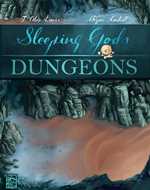
Sleeping Gods Board Game: Dungeons Expansion
Sleeping Gods: Dungeons adds six dungeons to Sleeping Gods. Each dungeon includes a map and stories. In a dungeon, gameplay will be slightly altered from the regular game.
Each map is printed on thick card stock (Letter-sized, 8.5?11 inches). A separate dungeon booklet contains all of the descriptions, encounters, and puzzles that you'll experience as you explore.
You can access these dungeons at specific locations in the atlas of the Sleeping Gods base game. When you reach a location that contains a dungeon, you can choose to read from the standard storybook, or instead explore the dungeon that is located there. The specified location number is listed in the top left corner of the dungeon map.
Each dungeon holds dangerous traps, vicious monsters, and treasure that you can find. Because dungeons take longer to explore than a standard location, there are a few small changes to game play when you enter one. While in the dungeon, players take turns taking two actions each, which include moving to new rooms, examining your surroundings, and more.

Sleeping Gods Board Game: Primeval Peril
Survive the River. You've been transported to a strange world. You must survive the dangers of a jungle river and rescue a kidnapped passenger. Travel through the atlas, exploring locations, and completing quests to find your lost companion before he perishes! Primeval Peril takes place in the Wandering World, a mythical place that is also the setting of Sleeping Gods and Sleeping Gods: Distant Skies.
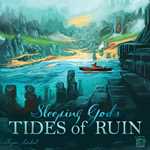
Sleeping Gods Board Game: Tides Of Ruin Expansion
The Wandering Sea is vast, filled with hidden treasures and lost totems. To the far south lies Zokmere, the sanctuary city, where hundreds of splintered houses cling to the jungle hills in a turquoise bay. In the northeast, the gods hide the remains of a sprawling city, and the history of their malice. Ready your crew. New dangers and adventures await. Sleeping Gods: Tides of Ruin expands the world of Sleeping Gods with a second atlas, accompanying storybook, new adventure cards, enemies, events, and more. Seamlessly combine this expansion with the base game to make the world even larger.






